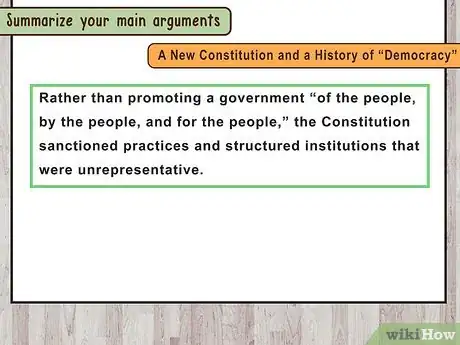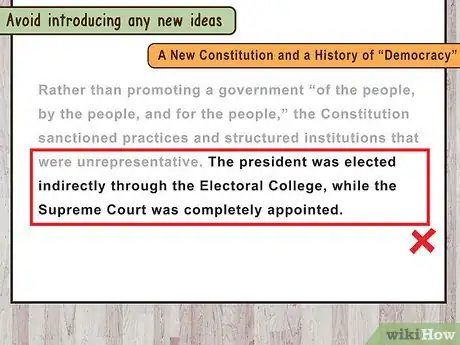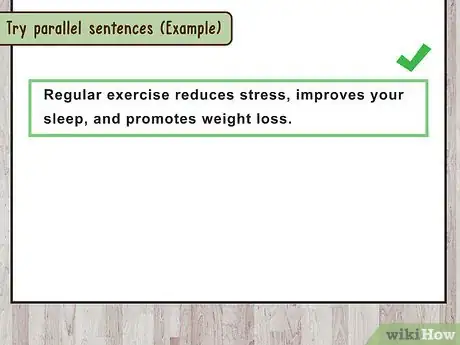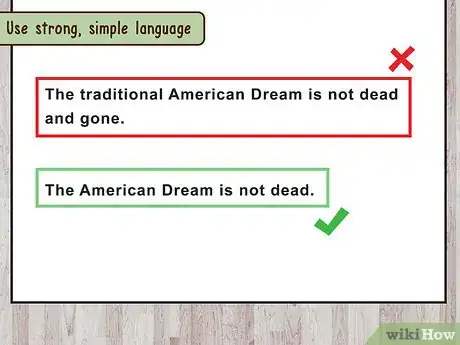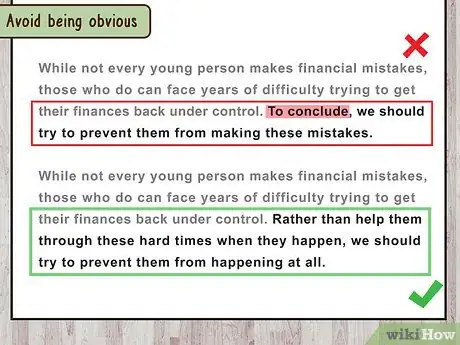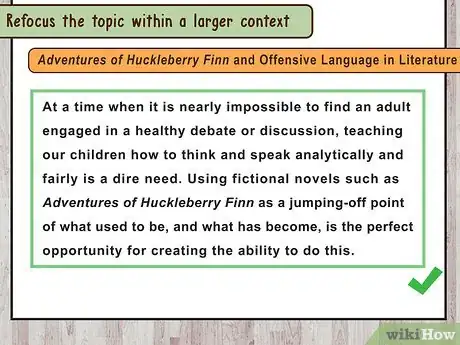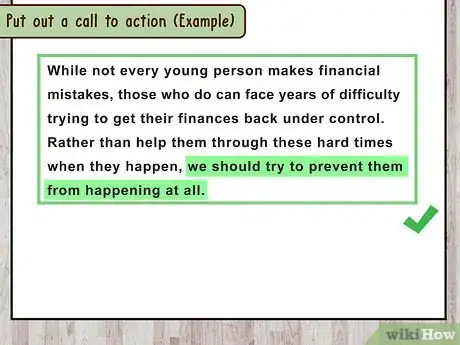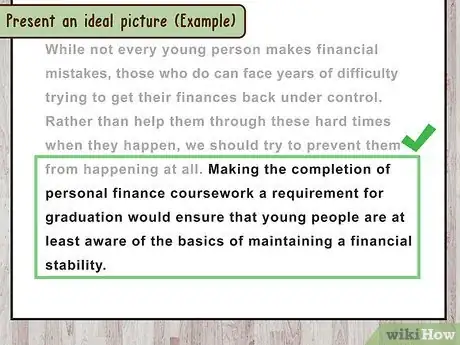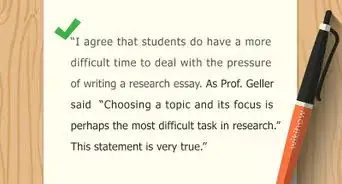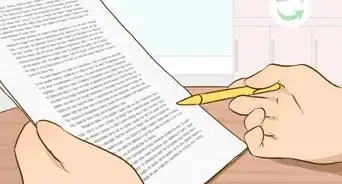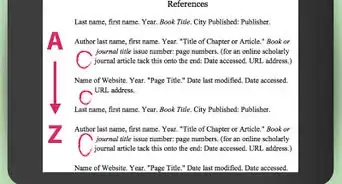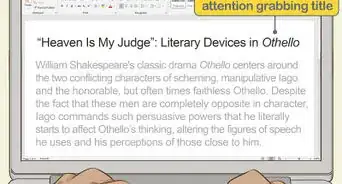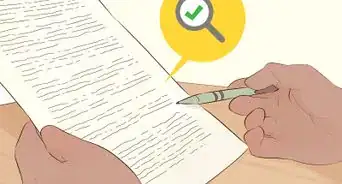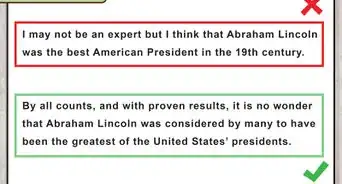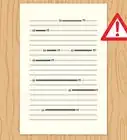This article was co-authored by Jake Adams. Jake Adams is an academic tutor and the owner of Simplifi EDU, a Santa Monica, California based online tutoring business offering learning resources and online tutors for academic subjects K-College, SAT & ACT prep, and college admissions applications. With over 14 years of professional tutoring experience, Jake is dedicated to providing his clients the very best online tutoring experience and access to a network of excellent undergraduate and graduate-level tutors from top colleges all over the nation. Jake holds a BS in International Business and Marketing from Pepperdine University.
This article has been viewed 160,967 times.
Persuasive essays introduce a hypothesis in the introduction and set out to prove it within the body of the text.[1] A good concluding paragraph for a paper should summarize your hypothesis and all your key arguments in about 3-5 sentences. Use parallel sentences and simple language, and avoid being obvious. Establish the importance of your conclusion by looking at the topic within a bigger context, presenting an ideal picture, and calling your reader to action.
Steps
Giving an Overview
-
1Re-read your paper or paper outline. Organize your thoughts before writing your concluding paragraph by re-reading the rest of the paper, or the outline you made before writing it (if you made one).[2] Isolate the key arguments made within the body of your writing, as well as the hypothesis proposed in the introductory paragraph.
- If it helps, print out a copy of the body of the paper and highlight the main points to be summarized.
-
2Summarize your main arguments. Your concluding paragraph should repeat the main points that you made within your paper in different words. Briefly summarize the key arguments that make up the body of your essay in a clear and concise manner. Make sure to include important keywords from each point in your conclusion.[3]
- For instance, "Gun laws should be changed to reflect the evolving needs of today's generations.”
Advertisement -
3Avoid introducing any new ideas. When concluding any kind of essay, avoid introducing an idea that isn't already in the body of the paper. If you feel the need to add something new to the conclusion, consider editing the body of your paper to include that information. For example, avoid adding a point about how fashion magazines provide unrealistic portrayals of the male body if your paper has focused solely on how these magazines affect women.[4]
- You can, however, create a call to action or end with a creative and engaging hook statement.
-
4Keep it brief. In an academic paper, your concluding paragraph should only be about 3-5 sentences long. Be efficient in your writing and communicate what you need to say as briefly as possible. To stay within this sentence range, try:[5]
- Using the first sentence to restate the hypothesis in your introduction, in different wording
- Writing the next 2-3 sentence to summarize the key arguments made in your paper
- Having the last 1-2 sentences be a grand statement of conclusion, saying what your final findings are
Using Convincing Wording
-
1Try parallel sentences. When summarizing parts of your research or arguments, use parallel sentences. This writing technique uses patterns of similar words to organize thoughts or ideas and show the reader that they are similar, or equal in value. In a concluding paragraph, parallel sentences can help organize information in a way that allows you to avoid writing too much.[6]
- For instance, "Regular exercise reduces stress, improves your sleep, and promotes weight loss."
-
2Use strong, simple language. Your concluding paragraph should drive your point home in a straightforward, assertive way. Avoid too much detail in your writing (such as lengthy adjectives or descriptions), as it can be distracting. Choose the simplest manner to say what you want to communicate.[7]
- For instance, instead of writing, "The traditional American Dream is not dead and gone," write, "The American Dream is not dead.”
- However, keep in mind that in some cases, more elaborate wording may be necessary to drive home your point.
-
3Avoid being obvious. A well-written paper does not need to use phrases like "to conclude" or "to summarize" in its conclusion. Restate your ideas in a different way, in a paragraph that can stand alone as a summary of your research. Your reader, having read the rest of your paper, will understand on their own that you are summing up the contents of your essay and presenting your conclusion.[8]
Establishing the Relevance of Your Conclusion
-
1Use the "Panning to the Horizon" technique to assert the importance of your research. In addition to summarizing the main points of your paper, your conclusion should point towards how your findings will be relevant in the future. You can achieve this by refocusing the topic within a larger context, and inviting the reader to reflect on how it will play out within a bigger picture. Use a thought-provoking question to communicate that the issue deserves further thought.
- For example,"What will happen to small businesses as different industries continue to go digital?"
-
2Put out a call to action to engage your reader in a memorable way. Establish the importance of your essay's conclusion by challenging your reader to do something about it. Turning your final findings into a real life challenge will emphasize the relevance of the topic and your hypothesis.[9]
- For example, "Being environmentally responsible is a necessary step for all people, in order to save the parts of nature that we have left."
-
3Present an ideal picture to improve your reader's relation to the text. If your essay has presented a hypothesis about how something is bad, create a picture of how things could be better. The optimistic focus will re-frame your arguments in a more positive way. The possible solutions to the issue your have arguments have established gives merit to your thesis without undermining the structure of your paper or altering the arguments you made.[10]
- For example, "If this competitive nature of school work were replaced with a more community-based learning approach, we might see happier, healthier children."
Community Q&A
-
QuestionHow do I write a persuasive letter?
 SapphiaCommunity AnswerA persuasive letter can be written in the same format as a persuasive essay, but with an address at the beginning and a personal closing. It may also be shorter than a persuasive essay.
SapphiaCommunity AnswerA persuasive letter can be written in the same format as a persuasive essay, but with an address at the beginning and a personal closing. It may also be shorter than a persuasive essay. -
QuestionHow do I choose a topic for a persuasive essay?
 SapphiaCommunity AnswerTry to choose something you're interested in, then narrow it down from there. If you like dance, write a paper persuading the reader that dance is beneficial to the body in many ways. If your passion is painting, write that paintings have a strong impact on human history. Try to find a way to tie in something you are passionate about with whatever you decide to write your paper on.
SapphiaCommunity AnswerTry to choose something you're interested in, then narrow it down from there. If you like dance, write a paper persuading the reader that dance is beneficial to the body in many ways. If your passion is painting, write that paintings have a strong impact on human history. Try to find a way to tie in something you are passionate about with whatever you decide to write your paper on. -
QuestionHow can I make a amazing concluding sentence for a persuasive paragraph?Whatever you end up with, make it brief. Brevity is the soul of wit. Think of the point you made, and repeat that in your last sentence in a powerful, balled-up wording, preferably using alliteration, assonance and the like. Be brief, but prove to be persuasive.
References
- ↑ Jake Adams. Academic Tutor & Test Prep Specialist. Expert Interview. 20 May 2020.
- ↑ Jake Adams. Academic Tutor & Test Prep Specialist. Expert Interview. 20 May 2020.
- ↑ https://opentextbc.ca/writingforsuccess/chapter/chapter-10-persuasion/
- ↑ https://opentextbc.ca/writingforsuccess/chapter/chapter-10-persuasion/
- ↑ http://penandthepad.com/write-concluding-paragraph-persuasive-essay-college-1412.html
- ↑ http://examples.yourdictionary.com/parallel-structure-examples.html
- ↑ http://writingcenter.fas.harvard.edu/pages/ending-essay-conclusions
- ↑ http://writingcenter.fas.harvard.edu/pages/ending-essay-conclusions
- ↑ https://owl.purdue.edu/owl/general_writing/common_writing_assignments/argument_papers/conclusions.html
About This Article
To write a concluding paragraph for your persuasive essay, you’ll need to briefly summarize your main arguments. Use the first sentence to restate your hypothesis from your introduction in different words. Then, spend 2 or 3 sentences reminding the reader of the main arguments you made throughout the essay. Use strong, simple language to emphasize your conclusion. You can also add a call to action or tell the reader what you think should happen as a result of your conclusions. For example, "If this competitive nature of school work were replaced with a more community-based learning approach, we might see happier, healthier children." For more tips from our Teaching co-author, including how to position your arguments within the bigger picture, read on!


